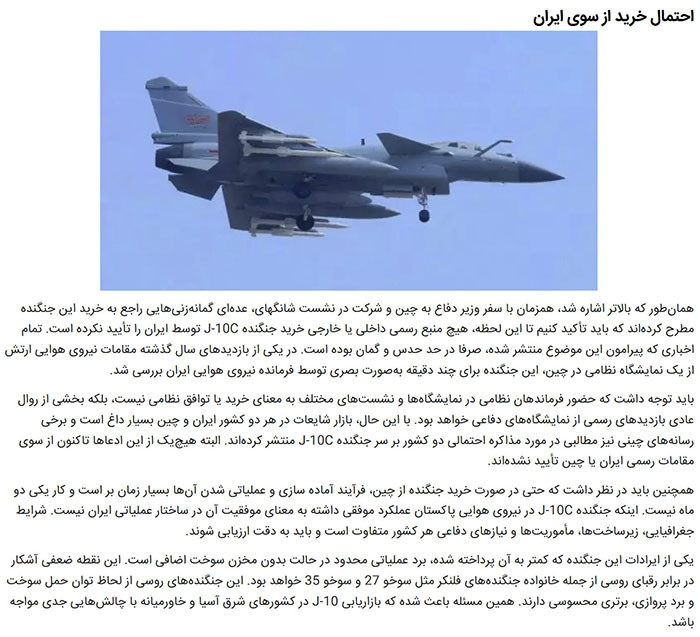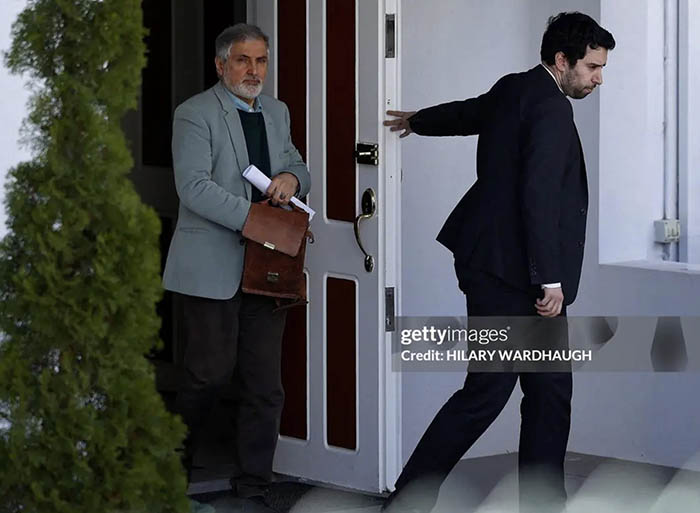Assessing the Possibility of Iran Acquiring the Chengdu J-10C Fighter Jet

4. Geopolitical and Diplomatic Considerations
China’s Strategic Interests
China’s export of military hardware, including fighters like the J-10C, is driven by multiple factors:
- Regional influence: Strengthening alliances and expanding China’s footprint in the Middle East.
- Economic gains: Generating revenue and fostering strategic partnerships.
- Military diplomacy: Building goodwill and expanding China’s influence in the global arms market.
Iran’s Strategic Goals
Iran’s pursuit of advanced fighters aligns with its broader goal of deterrence and regional influence. Acquiring the J-10C could:
- Enhance deterrence against regional rivals like Israel, Saudi Arabia, and the United States.
- Diversify its arsenal away from Russian platforms, reducing reliance on a single supplier.
- Strengthen alliances with China, which is increasingly viewed as a strategic partner.
International Sanctions and Restrictions
One of the major hurdles for Iran is the impact of international sanctions, particularly those imposed by the United States and its allies. These sanctions restrict Iran’s ability to purchase and import advanced military hardware legally.
- Black Market and Illicit Channels: Iran has historically used clandestine channels to acquire technology and equipment.
- China’s Position: While China generally adheres to international sanctions, it also values strategic relationships and may choose to bypass restrictions in certain cases.
Diplomatic Risks
- US and Western Response: A significant arms transfer to Iran involving advanced fighters could trigger diplomatic protests, sanctions, or military responses.
- Regional Stability: Such a move could destabilize regional balances, prompting countermeasures by adversaries.
Future Diplomatic Trends
As global geopolitics evolve, China’s willingness to support Iran’s military modernization may increase or decrease depending on broader strategic calculations, including economic interests, regional stability, and international pressure.
5. Logistical and Operational Challenges
Infrastructure Development
Iran would need to develop or upgrade airbases, maintenance facilities, and training centers compatible with the J-10C’s requirements.
Pilot and Technician Training
- Pilot Training: Pilots would require specialized training in China or third-party training facilities.
- Technician and Maintenance Staff: Maintenance personnel need to learn new systems, which could take years.
Supply Chain Management
- Spare Parts: Establishing a reliable supply chain for spare parts and upgrades is crucial.
- Upgrades and Modifications: Long-term maintenance and modernization programs would be necessary to keep the fleet effective.
Integration into Iran’s Military Doctrine
Iran would need to adapt its operational doctrine, tactics, and strategies to leverage the J-10C’s capabilities effectively.
Cost Considerations
Acquiring and maintaining a fleet of J-10Cs would be expensive, requiring significant financial resources and long-term commitment.
6. Historical Precedents and Lessons
Past Military Purchases
Iran has previously purchased or obtained military hardware through clandestine channels:
- Russian Su-24 and MiG-29: Despite sanctions, Iran acquired these aircraft via clandestine means.
- Chinese drones and missile technology: Iran has imported Chinese drones and missile systems as part of its military modernization.
Reverse Engineering and Indigenous Development
Iran has demonstrated the ability to reverse engineer foreign aircraft and develop indigenous variants, such as the Saeqeh fighter jet based on the American F-5.
Implications for Future Acquisition
These precedents suggest that Iran could develop or modify imported aircraft to suit its needs, even if initial purchase or import faces hurdles.
7. Future Prospects and Strategic Implications
Likelihood of Purchase
While no official agreements have been announced, the possibility remains plausible given Iran’s strategic needs and China’s willingness to export military technology. The time frame for such a purchase, if it occurs, could span several years.
Impact on Regional Security
- Balance of Power: The introduction of J-10C fighters could shift regional air power balances, especially if Iran successfully integrates and operates them.
- Arms Race: Neighboring countries may respond by upgrading their own fleets or seeking advanced aircraft.
- US and Allied Strategies: Western countries might increase their focus on Iran’s air capabilities and develop countermeasures.
Diplomatic Repercussions
A formal transfer of J-10C fighters to Iran could:
- Strain Iran’s relations with Western powers.
- Lead to increased sanctions or diplomatic isolation.
- Influence China’s relations with other regional actors.
8. Conclusion
The potential acquisition of the Chengdu J-10C fighter jet by Iran is a complex issue, intertwined with technological, strategic, diplomatic, and logistical considerations. While the aircraft’s capabilities make it an attractive option for Iran’s modernization efforts, numerous challenges—ranging from operational range limitations to sanctions—must be addressed.
Iran’s strategic ambition to bolster its air power remains evident, and the J-10C could be a valuable asset if procurement and integration hurdles are overcome. However, the timeline remains uncertain, and much depends on geopolitical developments, China’s willingness to support Iran, and the broader international context.
In sum, the possibility of Iran purchasing the J-10C cannot be dismissed outright but remains speculative until concrete steps are taken and official agreements are announced. Future developments in this area will be closely monitored by military analysts, policymakers, and regional security experts.




